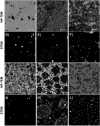Effect of C-terminus amidation of Aβ39-42 fragment derived peptides as potential inhibitors of Aβ aggregation
- PMID: 35515767
- PMCID: PMC9055537
- DOI: 10.1039/d0ra04788k
Effect of C-terminus amidation of Aβ39-42 fragment derived peptides as potential inhibitors of Aβ aggregation
Abstract
The C-terminus fragment (Val-Val-Ile-Ala) of amyloid-β is reported to inhibit the aggregation of the parent peptide. In an attempt to investigate the effect of sequential amino-acid scan and C-terminus amidation on the biological profile of the lead sequence, a series of tetrapeptides were synthesized using MW-SPPS. Peptide D-Phe-Val-Ile-Ala-NH2 (12c) exhibited high protection against β-amyloid-mediated-neurotoxicity by inhibiting Aβ aggregation in the MTT cell viability and ThT-fluorescence assay. Circular dichroism studies illustrate the inability of Aβ42 to form β-sheet in the presence of 12c, further confirmed by the absence of Aβ42 fibrils in electron microscopy experiments. The peptide exhibits enhanced BBB permeation, no cytotoxicity along with prolonged proteolytic stability. In silico studies show that the peptide interacts with the key amino acids in Aβ, which potentiate its fibrillation, thereby arresting aggregation propensity. This structural class of designed scaffolds provides impetus towards the rational development of peptide-based-therapeutics for Alzheimer's disease (AD).
This journal is © The Royal Society of Chemistry.
Conflict of interest statement
The authors declare no competing financial interest.
Figures












Similar articles
-
Synthesis and mechanistic study of Aβ42 C-terminus domain derived tetrapeptides that inhibit Alzheimer's Aβ-aggregation-induced neurotoxicity.Bioorg Med Chem Lett. 2024 Nov 1;112:129929. doi: 10.1016/j.bmcl.2024.129929. Epub 2024 Aug 14. Bioorg Med Chem Lett. 2024. PMID: 39151661
-
Structural and mechanistic insights into the inhibition of amyloid-β aggregation by Aβ39-42 fragment derived synthetic peptides.Eur J Med Chem. 2021 Feb 15;212:113126. doi: 10.1016/j.ejmech.2020.113126. Epub 2020 Dec 28. Eur J Med Chem. 2021. PMID: 33395622
-
C-Terminal Fragment, Aβ39-42-Based Tetrapeptides Mitigates Amyloid-β Aggregation-Induced Toxicity.ACS Omega. 2018 Aug 28;3(8):10019-10032. doi: 10.1021/acsomega.8b01522. eCollection 2018 Aug 31. ACS Omega. 2018. PMID: 31459130 Free PMC article.
-
Rationally Designed Peptides and Peptidomimetics as Inhibitors of Amyloid-β (Aβ) Aggregation: Potential Therapeutics of Alzheimer's Disease.ACS Comb Sci. 2017 Feb 13;19(2):55-80. doi: 10.1021/acscombsci.6b00116. Epub 2017 Jan 18. ACS Comb Sci. 2017. PMID: 28045249 Review.
-
Electrochemistry of Alzheimer Disease Amyloid Beta Peptides.Curr Med Chem. 2018;25(33):4066-4083. doi: 10.2174/0929867325666180214112536. Curr Med Chem. 2018. PMID: 29446720 Review.
Cited by
-
Peptide-based amyloid-beta aggregation inhibitors.RSC Med Chem. 2024 Dec 31. doi: 10.1039/d4md00729h. Online ahead of print. RSC Med Chem. 2024. PMID: 39882170 Free PMC article. Review.
-
Unnatural Amino Acids: Strategies, Designs, and Applications in Medicinal Chemistry and Drug Discovery.J Med Chem. 2024 Nov 28;67(22):19932-19965. doi: 10.1021/acs.jmedchem.4c00110. Epub 2024 Nov 11. J Med Chem. 2024. PMID: 39527066 Review.
References
-
- Gaugler J. James B. Johnson T. Marin A. Weuve J. 2019 Alzheimer's disease facts and figures. Alzheimer's Dementia. 2019;15:321–387. doi: 10.1016/j.jalz.2019.01.010. - DOI
-
- Alzheimer's Association, Alzheimer's Disease Facts and Figures, 2019, Please see: http://www.alz.org/facts/, accessed on 20.05.2020
-
- Wong D. Rosenberg P. Zhou P. Kumar A. Raymont V. Ravert H. Dannals R. F. Nandi A. Brašić J. Ye W. Hilton J. In vivo imaging of amyloid deposition in Alzheimer disease using the radioligand 18F-AV-45 (flobetapir F-18) J. Nucl. Med. 2010;51:913–920. doi: 10.2967/jnumed.109.069088. - DOI - PMC - PubMed
LinkOut - more resources
Full Text Sources

